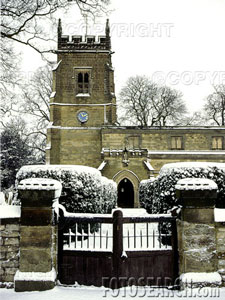 There are few sights that evoke "Englishness" more than that of a slumbering parish church. Cathedrals in England span only about 400 years of English history and cultural influence (with the exception of a very few modern cathedra, which don't evoke much of anything).
There are few sights that evoke "Englishness" more than that of a slumbering parish church. Cathedrals in England span only about 400 years of English history and cultural influence (with the exception of a very few modern cathedra, which don't evoke much of anything).
Parish churches, on the other hand, tell the tale of some 1300 years of English history and social change. The humble parish church is an integral part of English social life and culture.
The oldest surviving parish churches in England date to about 670 AD (Brixworth and Escombe). At that time 3 distinct classes of churches were built; "cathedral" churches, "collegiate" churches, and local churches/private chapels built by individual Anglo-Saxon thegns (lords).
Cathedral churches were not cathedrals in the modern sense, but "mother churches" from which the first missionary priests went out to preach Christianity to the pagan inhabitants in a particular region.
Collegiate churches, also known as "old minsters" were daughter houses of the cathedral churches; a sort of second level regional missionary church.
Churches, or chapels (only later called "parish churches"), were generally private foundations, established by thegns, bishops, lay societies, or even an association of parishioners.
The first parish churches were not built by the church, but by local lords. They were essentially owned and operated by that lord.
Churches were often located on pre-Christian sites of spiritual significance, taking advantage of people's existing devotion to a particular place. Worship was carried on in the same place, just with a Christian orientation. Speaking of orientation, churches are nearly always oriented so that the main altar is at the east end of the church, facing Jerusalem, and, not coincidentally, the rising sun. Even if the altar end of the church is not literally in the east, it is called the "east end". In theory at least, the east end of an English parish church could face west!
The origin of the English parish is murky. The term originally meant an administrative district. When the term "parish" was first applied to the church, it meant the territory of a bishop, what we would today call a diocese.
It is speculated by historians that parish boundaries were originally those of Saxon manors. The extent to which the church parish and the local lord's authority overlapped is apparent when you consider that before the Norman invasion one of the accepted ways of becoming a thegn was to build a church, especially one with a tower (the tower was a defensive measure against the threat of Danish invaders).
The thegn could install a priest of his own choosing, change the priest at will, even dismantle the church if he saw fit!
The chancel of the church was the domain of the priest, and the nave "belonged" to the parishioners. Each was responsible for the upkeep of their domain. This helps explain the curious architecture of some early parish churches, particularly in Norfolk and Suffolk, where the chancel is built of carefully squared stone, and the nave of much cheaper flint.
The basic architectural characteristics of the Saxon parish churches are: rectangular east end, side entrance (usually on the south side), and a west tower.
点击查看本频道更多精彩内容